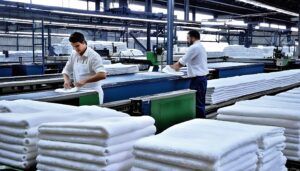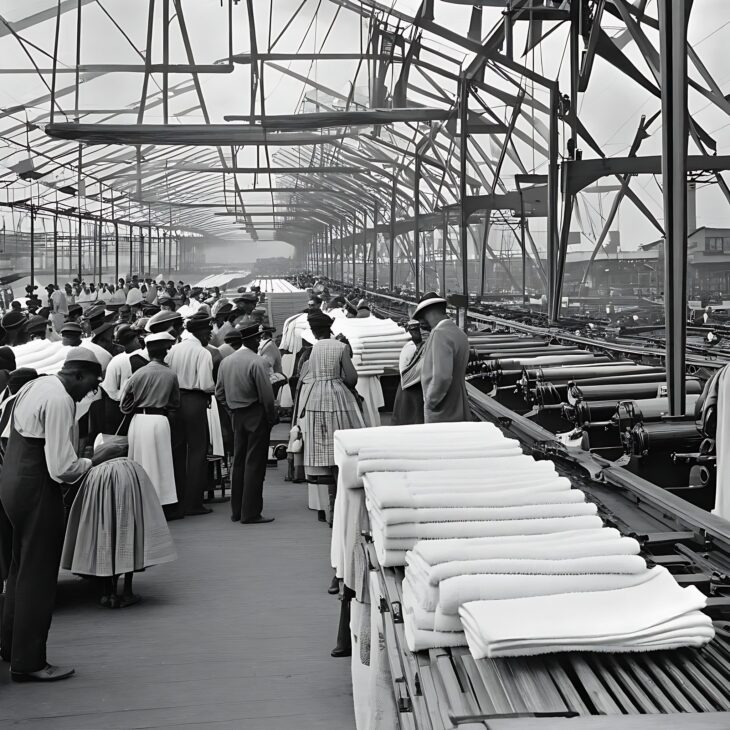Industrial Revolution of Towels: A Textile Transformation
Introduction
A significant turning point in history, the Industrial Revolution of Towels saw the transition from handcrafted, traditional handicraft to mass-produced, mechanical production. The textile industry was completely transformed, and the production and use of towels were completely changed throughout this fast-paced technological time. Using labor-intensive manual procedures, experienced artisans created rare and expensive towels during the pre-industrial era. Towels became more widely available and more reasonably priced for people from all walks of life, though, as industrialization took hold and advances in textile machines made it possible to produce towels in large quantities. This change had profound effects on society, the economy, and the environment in addition to democratizing the supply of towels.
From Scarcity to Spindles:
“From Scarcity to Spindles” illustrates the evolution of towels from rare, artisanal luxury items to mass-produced necessities. Towels were painstakingly made by trained artisans employing age-old methods, and they served as prestige and wealth markers in the pre-industrial period. But with the development of automated procedures and mechanical looms, industrialization brought about a revolution in the manufacture of towels. Towels became more widely available and more reasonably priced as a result of the transition from human labor to automation, hence enabling the general public to afford them. The growth of textile industries changed economies and cultures by causing urbanization and job possibilities. Towels are now commonplace household objects that come in an endless variety of styles, dimensions, and materials, which reflects the influence of the industrial revolution on daily life.
Enter the Spinning Jenny,
The Industrial Revolution’s groundbreaking creation, the Spinning Jenny, fundamentally altered the textile industry. This clever spinning machine, built by James Hargreaves in the late 1700s, had a profound impact on the industry. The Spinning Jenny significantly enhanced yarn output rates by enabling one worker to run numerous spindles at once. The industry entered a new phase of mass production with the breakthrough in textile manufacturing, which also resulted in a spike in efficiency. An essential component of the textile revolution, the Spinning Jenny produced superior-grade yarn at a significantly lower cost and time. The development of textile industry and the economic success of industrializing nations were caused by its widespread use.
The Dyeing Symphony:
In the textile business, especially during the Industrial Revolution, “The Dyeing Symphony” captures the colorful story of color. Dyeing processes advanced at the same time as machines did, revolutionizing production. Textiles became more widely available and varied during this time, creating a symphony of color. The range of color options has expanded with the replacement of natural dyes, which were originally widely used. Novelties like William Henry Perkin’s artificial coloring method, which he created in 1856, completely transformed the sector. This discovery enhanced colorfastness and durability in addition to expanding the range of available colors. Textile industrialization was propelled further by the dyeing process’s increased effectiveness and economy. A lasting impact on society, the widespread use of vibrant textiles revolutionized fashion, design, and daily living.
Innovation Never Dries:
The expression “Innovation Never Dries” captures the dynamic nature of the textile industry, particularly with regard to drying techniques. Efficiency and quality-driven innovation has driven continuous advancements, ranging from traditional methods to state-of-the-art creations. In the pre-industrial era, textiles were dried using straightforward techniques like air drying or exposure to sunshine. But as industrialization increased, mechanical drying methods—such as steam-powered drying machines—appears. These innovations improved textile manufacturing efficiency and throughput while revolutionizing the drying process. With advancements like infrared drying and air flotation dryers that maximize drying times and energy consumption, the industry is continuously evolving today. The industry’s quest of innovation in drying techniques demonstrates its commitment to efficacy, sustainability, and quality.
The Social Spin-off:
“The Social Spin-off” demonstrates how the Industrial Revolution had significant social ramifications, especially for the textile sector. Mechanization changed social dynamics and structures in addition to production. Significant changes in labor conditions and urbanization resulted with the transition from cottage industries to factory-based production. Debates on labor rights and social welfare were sparked by the hard working conditions and long hours endured by factory workers, including women and children. For communities, the rise of textile mills as major centers of economic activity brought both opportunities and difficulties. Furthermore, urban growth and cross-cultural contact were stimulated by the flood of rural migrants into industrial towns. The textile industry’s societal fallout shaped attitudes, laws, and the structure of daily life all across society.
The Unraveled Threads:
“The Unraveled Threads” reveals the intricate workings and difficulties of the Industrial Revolution textile business. The strain on labor forces and industrial systems increased along with the demand for textiles. Mechanization destroyed long-standing customs and means of subsistence even while it offered efficiency and scale. Craftsmen were unable to compete with companies that used machinery, which caused instability in cottage industries. work movements and societal unrest were spurred by the shift from specialized craftsmen to factory work, underscoring the human cost of industrialization. Furthermore, requests for sustainability were sparked by environmental worries about manufacturers’ pollution of landscapes and waterways. The demise of customary textile methods revealed conflicts between development and conservation, influencing the course of both the sector and society.
Pre-Industrial Towel Era
Before industrialization, towels were made by highly talented artisans, and their creations were rare and opulent. Towels, which were created by hand using age-old methods, were not just commonplace items but also prestige and wealth markers. Handmade towels were considered exclusive due to the high value placed on materials such as cotton and linen. Each towel was meticulously made during the labor-intensive production process. In addition to their essential uses, towels were used in homes as ornamental accents and status symbols. Towels were confined to the domain of luxury goods since they were expensive and only available to the wealthy. Pre-industrial towels were rare, although when they were found, they displayed remarkable creativity and skill that reflected the ideals and tastes of the day.
The Industrial Revolution’s Impact
The late 18th and early 19th centuries saw the Industrial Revolution, which changed commerce, technology, and society. Automating processes led to notable improvements in productivity and efficiency across a variety of industries. Before unimaginable levels of mass manufacturing were made possible by technology and the widespread usage of steam power, which revolutionized industry. An increase in industrial centers and urbanization resulted from the economy’s move from manual labor to automated production processes. The Industrial Revolution paved the way for additional modern advancements in addition to enhancing communication, transportation, and infrastructure.

Technological Advancements in Towel Production
With the revolution of manufacturing processes brought about by technological developments in towel manufacture, there is now greater customisation, quality, and efficiency. Production has become more efficient because to automation and computerized technologies, which also enable precise control over processes like cloth weaving, cutting, and finishing. It is now possible to create complex motifs and patterns on towels thanks to advanced looms and weaving techniques, which also improve their visual appeal. The variety of materials accessible for towel production has increased thanks to advancements in fiber technology, including recycled fibers, textiles made from bamboo, and organic cotton. Further customizing options are made possible by the vivid and intricate designs that can be printed directly into towels thanks to advancements in digital printing technology. Towel production now incorporates quick-drying and antibacterial treatments, enhancing ease of use and hygienic standards.
Changing Trends in Towel Usage
Technological advancements and changes in consumer tastes have an impact on how towels are used and viewed in various contexts. Concerns about sustainability and growing environmental consciousness are driving some notable trends, like the shift to eco-friendly materials. Towels consisting of organic cotton, bamboo, and recycled fibers are in more demand because they align more closely with the values of ethical customers. Towels that dry quickly and are lightweight are becoming more and more popular as a way to satisfy the needs of modern travelers and busy lifestyles. In addition, hotels are beginning to embrace personalization by giving patrons branded or personalized towels to enhance their stay and give them a sense of exclusivity.
Globalization and Towel Industry
The towel industry is now a dynamic, integrated worldwide market as a result of globalization’s profound effects. Innovation and efficiency in the manufacture of towels have been fueled by increased commerce and accessibility to global markets, which have enabled the exchange of raw materials, technology, and expertise. Thanks to the global sourcing of materials, manufacturers are now able to provide a wide variety of towels to cater to different customer wants and tastes. Towels may now be easily found in marketplaces all over the world because to the growth of distribution networks brought about by globalization. Because of this, manufacturers are now more competitive, which benefits consumers by increasing choice, price, and quality. Further encouraging information sharing and industry advancements, globalization has enabled the expansion of cross-border collaborations and partnerships.
Challenges Faced by the Towel Industry
There are various obstacles that the towel sector must overcome to maintain profitability and smooth operations. Geopolitical tensions, weather patterns, and worldwide demand are some of the causes that can cause fluctuations in the prices of raw materials, especially cotton. This poses a substantial challenge to the industry. Moreover, manufacturers have difficulties due to growing labor expenses and the rivalry for highly qualified people, particularly in areas with strict labour laws. Concerns about water use, chemical contamination, and waste management during the production process are a major problem for the towel business, making environmental sustainability an especially urgent issue. Further driving up production costs are investments in sustainable materials and processes brought on by growing consumer demand for eco-friendly products.

Innovations in Towel Design and Functionality
The textile sector is changing as a result of innovations in towel design and functionality, which give customers a variety of options to meet their various demands and tastes. The incorporation of smart textile technologies—such as materials that regulate temperature or wick away moisture—to improve comfort and performance is one prominent trend. Additionally, sophisticated patterns and textures can be created using advanced weaving processes, giving towels a more opulent and eye-catching appearance. Cutting-edge finishes that meet hygienic and sensory preferences, including embedded perfumes or antibacterial treatments, improve the user experience. Furthermore, compact and lightweight towels made for outdoor sports or travel provide convenience without sacrificing softness or absorbency.
Towels in the Digital Age
Towels are evolving in the digital age due to shifting consumer expectations and technological advancements. The use of sensors or microchips in smart textiles is becoming more common. These fabrics may detect wetness or provide UV protection, for example, improving functionality and user experience. Furthermore, customers can create and customize their towels using online customization platforms by choosing the colors, patterns, and monograms that best fit their tastes. The process of buying has been simplified by e-commerce platforms, which allow customers to explore and purchase towels from the comfort of their homes with the option of doorstep delivery. Social media networks function as avenues via which firms present their most recent towel designs, interact with customers, and obtain feedback, so impacting consumer purchasing decisions.
The Future of Towel Manufacturing
Technology breakthroughs and shifting consumer tastes will fuel innovation and change in the towel manufacturing industry in the coming years. With capabilities like moisture detection, temperature control, and UV protection, smart textiles equipped with sensors or microchips are predicted to completely transform towel functionality. There will be a rise in the use of sustainable resources and industrial techniques, which reflects the importance of resource conservation and environmental responsibility. Robotics and automation will simplify industrial procedures, increasing productivity and lowering labor expenses. Customers will be able to add distinctive patterns, hues, and features to their towels as customization choices increase. Furthermore, improvements in 3D printing technology could completely change the towel industry by enabling on-demand production and cutting waste.
Conclusion
In conclusion, from a basic function to a sophisticated component of comfort and luxury in the hotel sector and beyond, the modest towel has come a long way. Terry towels have been a staple for generations because to its inventiveness and adaptability, which has improved visitor experiences and raised the bar for cleanliness and quality. Future developments in technology, environmental efforts, and shifting customer tastes will likely bring about much more change in the towel sector. The future of towel production promises innovation, efficiency, and individualized experiences with smart fabrics, eco-friendly materials, and digital platforms and personalization choices. The towel sector will flourish if it embraces these trends and obstacles, offering consumers cutting-edge goods that enhance ordinary occasions and rethink the function of towels in our lives.


[…] The Industrial Revolution ushered in a towel revolution. Advances in weaving and textile production made towels more affordable and accessible. Cotton emerged as the dominant material, prized for its softness, absorbency, and durability. By the early 20th century, terrycloth weaving, characterized by looped yarn that amplified surface area and absorption, became the gold standard. […]
Good attempt
Amazing
Very nice